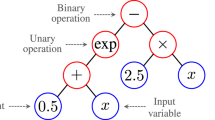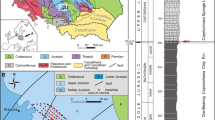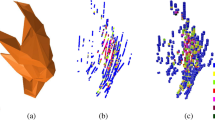Abstract
When characterizing and simulating underground reservoirs for flow simulations, one of the key characteristics that needs to be reproduced accurately is its connectivity. More precisely, field observations frequently allow the identification of specific points in space that are connected. For example, in hydrogeology, tracer tests are frequently conducted that show which springs are connected to which sink-hole. Similarly well tests often allow connectivity information in a petroleum reservoir to be provided.
To account for this type of information, we propose a new algorithm to condition stochastic simulations of lithofacies to connectivity information. The algorithm is based on the multiple-point philosophy but does not imply necessarily the use of multiple-point simulation. However, the challenge lies in generating realizations, for example of a binary medium, such that the connectivity information is honored as well as any prior structural information (e.g. as modeled through a training image). The algorithm consists of using a training image to build a set of replicates of connected paths that are consistent with the prior model. This is done by scanning the training image to find point locations that satisfy the constraints. Any path (a string of connected cells) between these points is therefore consistent with the prior model. For each simulation, one sample from this set of connected paths is sampled to generate hard conditioning data prior to running the simulation algorithm. The paper presents in detail the algorithm and some examples of two-dimensional and three-dimensional applications with multiple-point simulations.
Similar content being viewed by others
References
Alcolea A, Renard P (2010) Blocking moving window algorithm: conditioning multiple-point simulations to hydrogeological data. Water Resour Res 46:W08511
Allard D (1994) Simulating a geological lithofacies with respect to connectivity information using the truncated gaussian model. In: Armstrong M, Dowd P (eds) Geostatistical simulations: proceedings of the geostatistical simulation workshop, Fontainebleau, France, 27–28 May 1993. Kluwer Academic, Norwell, pp 197–211
Allard D, Heresim Group (1994) On the connectivity of two random set models: the truncated gaussian and the boolean. In: Soares A (ed) Geostatistics Tróia ’92. Kluwer, Norwell, pp 467–478
de Marsily G, Delay F, Gonçalvès J, Renard P, Teles V, Violette S (2005) Dealing with spatial heterogeneity. Hydrogeol J 13:161–183
Deutsch C (1998) Fortran programs for calculating connectivity of three-dimensional numerical models and for ranking multiple realizations. Comput Geosci 24:69–76
Gómez-Hernández J, Wen X-H (1998) To be or not to be multi–gaussian? A reflection on stochastic hydrogeology. Adv Water Resour 21:47–61
Hoshen J, Kopelman R (1976) Percolation and cluster distribution. I. Cluster multiple labeling technique and critical concentration algorithm. Phys Rev B, Condens Matter Mater Phys 14:3438–3445
Journel A, Alabert F (1990) New method for reservoir mapping. J Pet Technol 42:212–218
Journel A, Deutsch C (1993) Entropy and spatial disorder. Math Geol 25:329–355
Kerrou J, Renard P, Hendricks Franssen H, Lunati I (2008) Issues in characterizing heterogeneity and connectivity in non-multigaussian media. Adv Water Resour 31:147–159
Knudby C, Carrera J (2005) On the relationship between indicators of geostatistical, flow and transport connectivity. Adv Water Resour 28:405–421
Krishnan S, Journel A (2003) Spatial connectivity: from variograms to multiple-point measures. Math Geol 35:915–925
Mariethoz G, Renard P, Straubhaar J (2010) The direct sampling method to perform multiple-point geostatistical simulations. Water Resour Res 46:W11536
Neuweiler I, Cirpka O (2005). Homogenization of Richards equation in permeability fields with different connectivities. Water Resour Res 41
Nurafza P, King P, Masihi M (2006) Facies connectivity modelling: analysis and field study. In: Hanna G (ed) SPE Europe/EAGE annual conference and exhibition. Society of Petroleum Engineers, Vienna, p SPE 100333
Stauffer D, Aharony A (1994) Introduction to percolation theory, 2nd edn. Taylor & Francis, London
Straubhaar J, Renard P, Mariethoz G, Froidevaux R, Besson O (2011) An improved parallel multiple-point algorithm using a list approach. Math Geosci 43(3):305–328. doi:10.1007/s11004-011-9328-7
Strebelle S (2002) Conditional simulation of complex geological structures using multiple-point statistics. Math Geol 34:1–21
Western A, Blöschl G, Grayson R (1998) How well do indicator variograms capture the spatial connectivity of soil moisture? Hydrol Process 12:1851–1868
Western A, Blöschl G, Grayson R (2001) Toward capturing hydrologically significant connectivity in spatial patterns. Water Resour Res 37:83–97
Zhang T, Switzer P, Journel AG (2006) Filter-based classification of training image patterns for spatial simulation. Math Geol 38(1):63–80
Zinn B, Harvey C (2003) When good statistical models of aquifer heterogeneity go bad: a comparison of flow, dispersion, and mass transfer in connected and multivariate gaussian hydraulic conductivity fields. Water Resour Res 39:1051
Author information
Authors and Affiliations
Corresponding author
Rights and permissions
About this article
Cite this article
Renard, P., Straubhaar, J., Caers, J. et al. Conditioning Facies Simulations with Connectivity Data. Math Geosci 43, 879–903 (2011). https://doi.org/10.1007/s11004-011-9363-4
Received:
Accepted:
Published:
Issue Date:
DOI: https://doi.org/10.1007/s11004-011-9363-4




